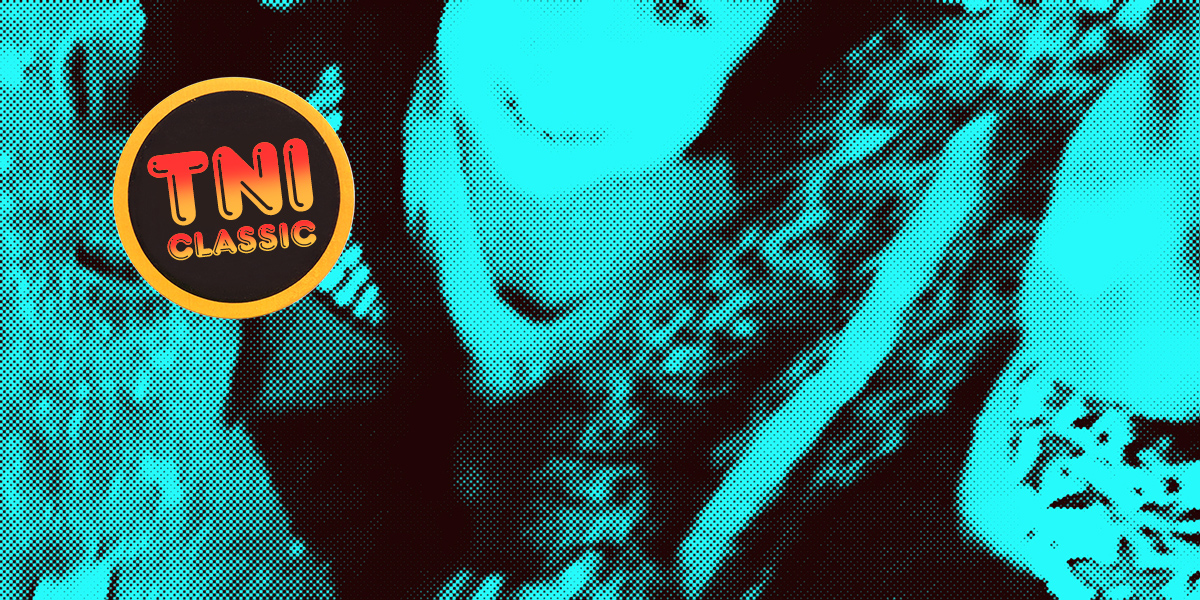CLOUDS Over Sidra, the U.N.’s first virtual reality documentary, follows a young Syrian refugee named Sidra who lives in a refugee camp in Jordan. The opening scene places the user, alone, in an unnamed desert. There are no people, only windswept sand dunes, crisscrossed with tire tracks and footprints. The user is able to look out across the desert in all directions, up to the sun, and down to the sand below her. If the user looks directly down, she doesn't see her feet or the base of the camera, but a collection of footprints, whose tracks span across the desert around her. She has no feet in this world, no physical form at all, but the marks of multiple feet are beneath her. Disembodied, she occupies the point at which all the footprints meet.
The creators of Clouds Over Sidra are two American men, Chris Milk and Gabo Aurora, and with their opening gesture, they have placed themselves within a legacy of Occidental writers and artists reflecting on the region. Footprints in the desert--whether of the traveler, or of the nomads, and erased by the wind--is a trope employed by generations of Occidental travel writers, politicians, poets and painters, from Lawrence Durrell to Gertrude Bell to Benjamin Disraeli, to mark that place as a blank slate on which they can write their own imaginings.
VR practitioners make a claim, as the early proponents of photography did, that it is a “slice of life,” “really being there,” “unmediated,” a “transparent communication.” But the footprints in Clouds Over Sidra suggest something else: a dense meeting point of different agendas above which the user is positioned, and through which the user views the world.
I first became interested in VR in the context of borders and bodies after my artistic collaborator, Hatem Hadawy, was unable to attend a festival in Amsterdam at which we had been invited to develop a new performance work. Hatem and I both live in Istanbul, and we both work in theater--an occupation that requires mobility for residencies and touring. However, his passport is Syrian and mine British, so at the moment, our abilities to take up these offers of international work vary wildly. This particular collaboration began as a series of conversations about the place of new technologies, such as VR, as tools of communication and virtual mobility in a world in which anti-mobility movements are rising. We had an interest in how these technologies lead double lives: they are at once vital communication tools for those separated from loved ones, and repressive tools for the governments that have imposed this separation; tools for organizing resistance and bringing bodies together in protest, as well as tools for creating division and controlling information. Just one example: in the time we’d both lived in Turkey, Twitter had gone from being an organizing platform for the people during the Gezi protests, to a machine for state propaganda, flooded by the paid trolls of Erdo?an’s Twitter-army.
One of the technologies that we had hoped to explore in this context was virtual reality, particularly in its relation to the conflict in Syria and the European crisis over refugees. In October of last year, the prominent game designer Paolo Pedercini tweeted his surprise at the number of VR videos on YouTube featuring refugee content. When I repeated his YouTube search for “refugee," filtered under “360 video” (the designation for virtual reality films) in late November, I received 995 results, which was 300 more than in the previous month. A search for “Syria,” filtered under “360 video,” yielded 1,120 results. Some of the highest profile VR releases have also borne out this affinity between VR and content featuring refugees, or the war in Syria. The New York Times launched their VR journalism department with a story about three refugee children, one of them Syrian. Yet in spite of the apparently humanitarian content of these works, VR’s genesis and development is in the military, where it has been used to train soldiers in “battle readiness,” a euphemism for: methods to overcome the innate human resistance to firing at another human being. In the last few years, VR's usage has shifted 180 degrees from a technology used to train soldiers for war, to one that claims to “amplify” the voices afflicted by war, and to affect “world influencers” who might be able to stop said wars.
There are a number of attempts to establish a set of journalistic ethics that account for the particularities of VR journalism and documentary. Through their documentary series Frontline, PBS and VR company Emblematic Group are currently developing a “best practices” guide for the field, while organizations such as the New York Times and others are engaging with the subject in articles. But the perspective of their ethical questions is to safeguard the consumer by asking whether the technical requirements of VR require an unethical level of influence on the part of the journalist; or whether the visceral nature of the technology might expose the viewer to traumatic imagery. So far, there has been little discussion of the ethics related to the subjects being filmed.
In Orientalism, Edward Said warned that in the “electronic, postmodern world [...] there has been a reinforcement of the stereotypes by which the Orient is viewed.” Especially pertinent to virtual reality is Said’s discussion of authority. He tells readers to look for an author’s “strategic location,” which he defines as “a way of describing the author’s position in a text.” In an immersive virtual reality environment, this position can be understood from the location of the camera, and subsequently, of the user. Clouds Over Sidra, for example, uses a number of different cameras to capture different views of the space; it then stitches together those different images to create the impression of a single, seamless, 360-degree shot. Unlike other types of VR that allow the users to control computer-generated game worlds with movements or buttons, 360 VR does not let the user navigate the world physically. Instead, the user occupies the position of the camera, and is only able to control where she looks within the boundaries of the camera’s range of capture. But while the immersive nature of this form might give the illusion that the user is within the frame, they are, in physical fact, anything but. The ultimate sensation created by the immersive 3D environment is that of positionlessness. “The Orientalist is outside the Orient, both as an existential and as a moral fact,” writes Said. In Clouds Over Sidra and other 360 VR’s, that “existential” and “moral fact” is made concrete: the user is propelled through a reality that they have the sensation of occupying physically, while their physical body remains apart from the consequences of being present in that space.
The convergence of VR journalism and documentary around content concerning Syria is based on the allure of this positioning. Proximity, it seems, offers a new way to engage an audience in a conflict whose documents, in the form of photographs, videos, and stories, have brought a world audience into a more intimate relation with crisis than ever. Chris Milk popularized a now-dominant idea of VR’s position in relationship to the war in Syria in a TED Talk where he claimed that VR heralded a “revolution in empathy.” His claim has since been widely discussed, disputed, and debunked.
IN
Milk’s TED Talk, he discusses the empathic potential of Clouds Over Sidra, telling his audience of the second scene of the film, which takes place in Sidra’s bedroom: “You’re not watching it through a television screen, you are sitting there with her. When you look down, you are sitting on the same ground she is sitting on, and because of that you feel her humanity in a deeper way, you empathize with her in a deeper way.” I decided to follow Milk’s instructions, and watch Clouds Over Sidra again, looking down at the ground, to see if his choice for the physical position of his camera would give any clues--beyond that first desert scene--as to what Said would call his “authorial position.”
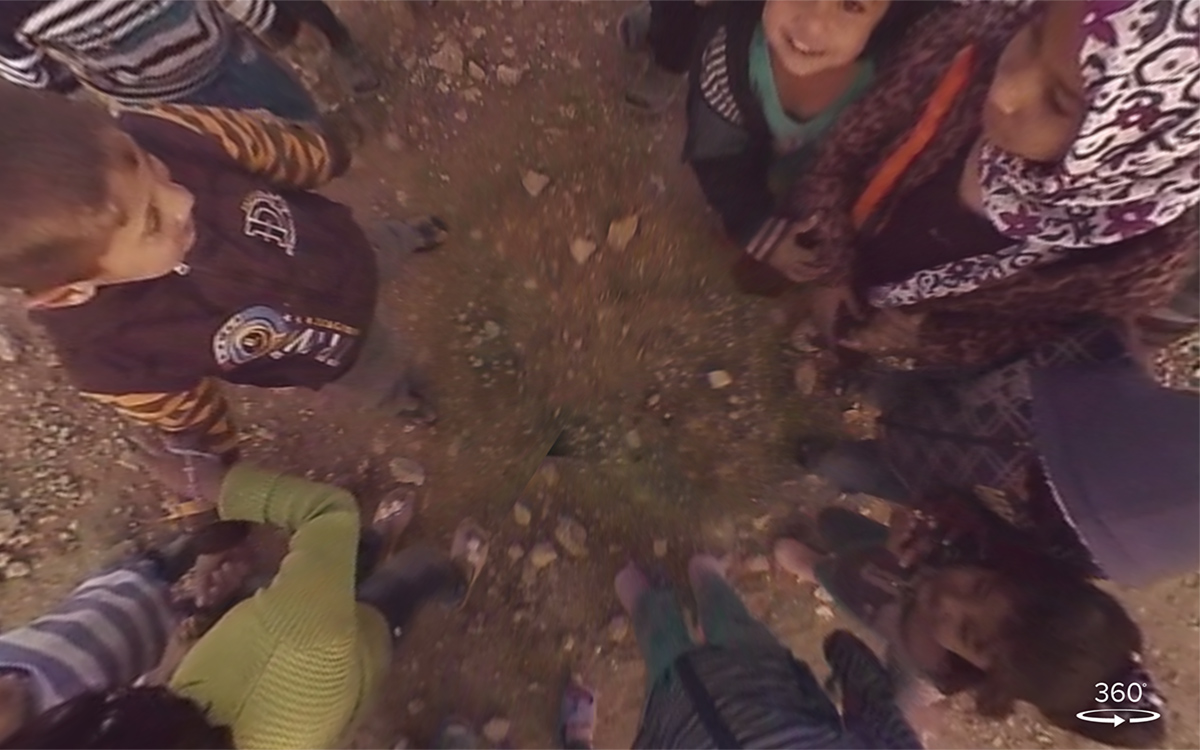
In one of the final frames of the piece, children crowd around the camera, looking up. The viewer, taking the place of the camera, is positioned at the center and above the subjects, given power and agency. In the first chapter of Orientalism, Said identifies the “essential relationship” that Europe has toward the “orient” as a relationship of strong toward weak, one common manifestation of which is the portrayal of the “oriental” as a child, or childlike, and the European as the mature adult. In Clouds Over Sidra the user, substituting for the camera, is placed into a literal enactment of that metaphorical relationship. This trope is not confined to Sidra. Hatem, my artistic collaborator, pointed out that Sidra and other 360 VR videos we watched on YouTube, predominantly feature children--as if a young man, an angry woman, or anyone challenging the positioning of the watcher/user, would knock a hole in the fragile attempts to provoke empathy.
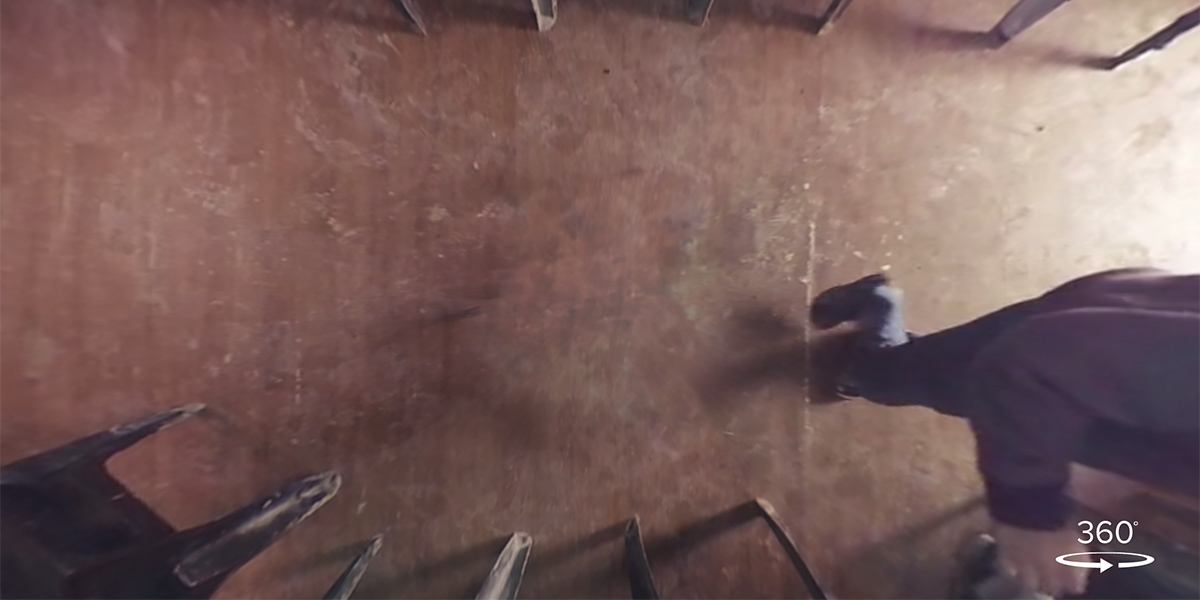
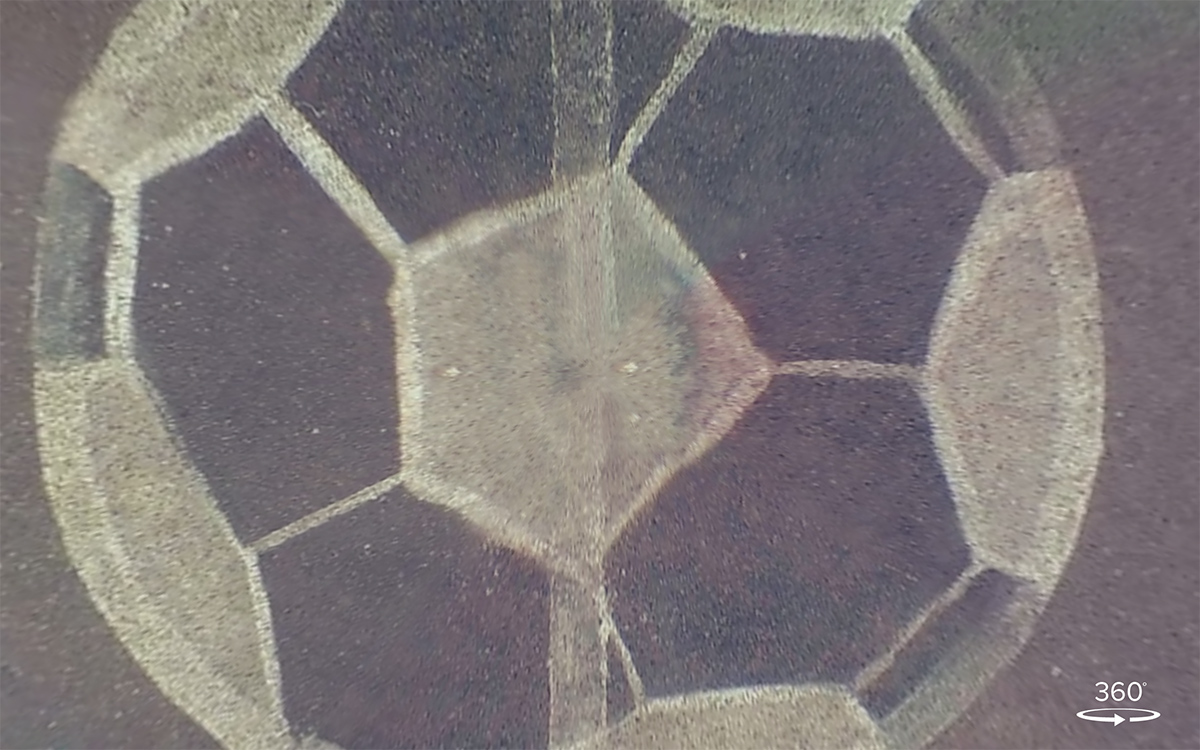
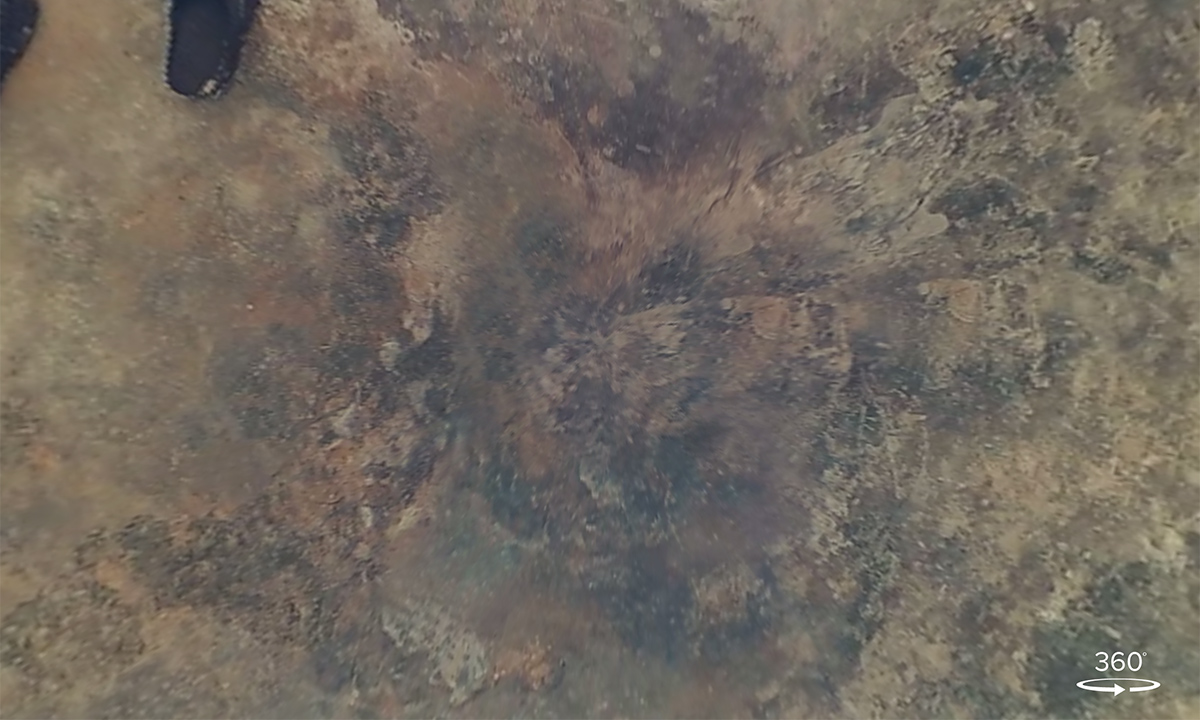
These stills from Clouds Over Sidra (from scenes in a computer room, at a sports ground, in her home) give a formalist clue as to the positioning of the maker/user. Each of them reveals the point located directly below the user to be a kind of skewed perspective, as if there were a sinkhole about to form and the world would collapse through it. It’s not accidental: this spot is the point at which the 3D camera images are stitched together. It is, in other words, the point beneath the camera tripod that must be patched over for the illusion of unmediated reality to be maintained. Milk said that his interest in VR came from his frustration with the limitations of the film frame: “A frame is a window--I wanted to put you through the window, into the other world.” VR might not be the rectangular frame of photography, but this strange spot demonstrates its nature as a spherical frame. Virtual Reality, no less than film or photography, is framed by its maker’s perspective.
To the degree that VR offers the illusion of greater proximity to the real than film or photography, it also increases the problematics of the medium. VR invites the user into a visual and aural immersion, without the user facing any of the consequences of being immersed in that space. By watching Clouds Over Sidra, or other “refugee VR,” users absolve themselves from the position of the neutral bystander by exercising their sympathetic, or empathetic, capacity. As Susan Sontag writes Regarding The Pain Of Others, “So far as we feel sympathy, we feel we are not accomplices to what caused the suffering. Our sympathy proclaims our innocence as well as our impotence. To that extent, it can be (for all our good intentions) an impertinent--if not inappropriate--response.” One of the 360 VR videos available on YouTube, made by a charity called Open Doors, illustrates this in its tag line, asking, “Have you ever wanted to look around a refugee camp? Enter a tent and sit down for a meal? See the kind of difference your support can make?” The questions reveal the intended audience of these videos: the “you” addressed is a user with no other connection to these spaces, a user with curiosity at a remove. This user’s only means of interaction with these spaces is their empathy--an affect creators hope to translate into action in the form of monetary donations.
CLOUDS
Over Sidra, on its own, should be easy enough to dismiss. That initial shot in the desert becomes an unintentional metaphor for whole piece, which writes its own perspective onto its subject in the guise of objective reality. Though she is the subject of the piece, Sidra’s voice is barely heard. For one scene she speaks, just audible below the English voice-over, before her voice is silenced completely. What we hear instead are the words of an actor (assuming it is an actor, as the voice-over is not credited in any of the materials) spoken in English. Even the name of Milk’s production company, Here Be Dragons, seems like a parody, borrowing a phrase from mythical markings on old maps of “undiscovered” regions, a trope of orientalist genre fantasies representing foreign places as strange, mysterious, and dangerous. But despite all of this, Clouds Over Sidra has become a foundational text in “truth-based” VR, both because of the authority afforded to it by the U.N. collaboration, and because of the influence of Milk’s TED Talk on discourse around the medium.
Clouds Over Sidra was launched as part of a U.N. campaign devoted to “new technologies,” which has promised to leverage “cutting-edge communication technologies to ensure a transparent dialogue between world influencers and their constituencies, especially the most marginalized and vulnerable populations.” But this “transparent dialogue” is neither transparent nor dialogic. Only one side speaks, only one side is able to hear or observe the other--and that observation is constructed and framed by the multitude of invisible presences that left those footprints in the sand.
Is there something intrinsically problematic about the form of VR, not just in the representation of refugees, or of the conflict in Syria, but in its attempts to represent the real? Other VR pieces have used the medium to make direct statements on the location of the user, drawing attention to the disembodiment, and to the double presence she occupies in both the virtual and physical worlds. Istanbul-based filmmaker Deniz Tortum's first VR work, Hospital With One Entrance and Two Exists, is created from point-cloud data generated by a laser scan of the Cerrahpa?a Hospital in Istanbul, a process he refers to as “machine vision.” As Tortum describes it, “The point-cloud reacts to the viewer, both to her gaze and to her head and body movement. This means that as the viewer moves, the points constituting the hospital corridor slowly appear to open up, with more and more empty space between them, and eventually dissolve.”
In Tortum’s piece, the space occupied by the camera (or, in this case, the laser point scanner) is not covered up, as it was in Clouds Over Sidra. Instead, the point is left empty. When the viewer leaves the initial spot, she can look back and see a black hole. She is still disembodied, but her absence from that space is, paradoxically, a reminder of her presence in the space. This absence is not just an aesthetic choice--it is political.
When I asked Tortum about his choices for the visualization of the world in Hospital with One Entrance, he told me, “There is an interview with the founder of Oculus Rift, and he says there is poverty and war, but we can give the experience of a wealthy person to those who are under-privileged. If we perfect virtual reality, we won’t need to perfect anything else. So an imperfect virtual reality world is a political act.” The statement he is referring to was made by Palmer Luckey, the inventor of Oculus Rift.
VR, created for military training and developed for commercial use by people like Luckey, stands at the intersection of colonial contexts, particularly when the subject matter is the conflict in Syria. VR’s claims to empathy, dialogue, and transparency, are based on a linguistic tic which uses spatial positioning as a metaphor for emotional or cognitive equivalence, as in the phrases, ?“to stand in someone’s shoes,” or even to “under-stand.” Under is from sanskrit antar, meaning between, or among, so “to understand” is “to stand among.” Physical relationship is a metaphor for emotional connection at the deepest levels of the English language, but geographical positioning does not automatically lead to an emotional or intellectual equivalence. The executioner stands on the same ground as the executed, and civil wars can turn neighbors into enemies. Occupying the same ground as another can be the basis for conflict--as that other sense of “occupy” reveals.
I'M
finishing this article on the plane to Amsterdam, to start work on Personal Empathy Machine. Hatem came with me to Ataturk Airport, and we watched the final moments of the U.S. election and Trump’s victory on his phone in the airport cafe, before he walked me to the passport check. This was as far as he could go, and our collaboration for the performance, by necessity, will be virtual. I’ll be in the space, on the stage, and he’ll be present as much as possible through the available technology. As we enter into an era where the spatial policing of bodies becomes more aggressive, what has happened in Syria should challenge our fundamental understanding of the inhumanity of borders. Instead, the political responses are restricting mobility even further.
In this world, of Erdo?ans, Trumps, and Le Pens, how many bodies will be denied absence to the physical space where they are needed? How many people will live with the absence of family, friends, partners--an absence made all the more acute by the tantalizing promise of virtuality? But the virtual can never replace the physical: all it can do is exacerbate its lack.
